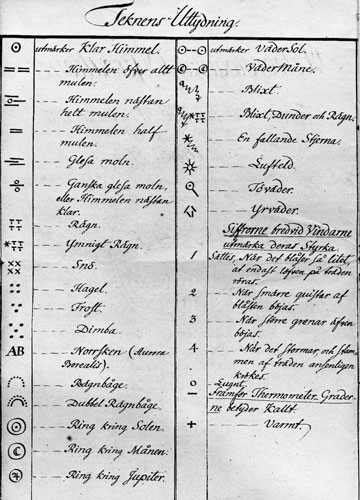Anders Moberg
Weather observations have been made continuously at the old astronomical observatory in Stockholm since 1754. The dataset provided here contains estimated cloud amount three times per day for the period 1756 – 2018.
Cloud amount and cloud types have been observed in several different ways through time, but the different observation routines are not always well documented.
This dataset consists of crude estimates of cloud amount for the period 1756 – 1858, based on interpretation of the reported observations, and observed cloud amount values for the period 1859 – 2018.
Download data
Weather symbols
Observations of cloud amount and other weather phenomena were in the 18th and 19th centuries often represented with various symbols that are not used today. The type of symbols and their meanings have differed somewhat from time to time. It is seldom clear exactly how to interpret these old symbols or how to translate them to cloud types and cloud amount that correspond to modern observations. This makes it difficult to quantify accurately how cloud amount has varied over time.
A legend from 1796
Legend found in a meteorological observation diary from Umeå, northern Sweden, written by D. E. Næzén in 1796. Similar weather symbols were used in Stockholm during 1784–1815.
Photo: Kurt Eriksson, National Archives. Source: Photo 2 in Moberg (1998).
Citation
Anders Moberg (2019) Stockholm Historical Weather Observations — Sub-daily cloud amount since 1756. Dataset version 1. Bolin Centre Database. https://doi.org/10.17043/stockholm-historical-cloud-amount-1
References
Moberg A. 1998: Meteorological observations in Sweden made before A.D. 1860. Paläoklimaforschung/Palaeoclimate Research 23: 99–119.
Moberg A, Alexandersson H, Bergström H, Jones PD. 2003: Were Southern Swedish summer temperatures before 1860 as warm as measured? Int. J. Climatol. 23: 1495–1521 (Sections 3–4 and Appendix A). https://doi.org/10.1002/joc.945
Data description
Data are provided in separate files for the following time periods:
1756-01-01 – 1784-06-01, in a scale from 1 to 3
1784-06-02 – 1815-12-31, in a scale from 1 to 6
1816-01-01 – 1841-06-30, in a scale from 1 to 4
1841-07-01 – 1858-12-31, in a scale from 1 to 6
1859-01-01 – 1872-12-31, in a scale from 0 to 4
1873-01-01 – 1960-12-31, in a scale from 0 to 10
1961-01-01 – 2012-12-31, in a scale from 0 to 8
2013-01-01 – 2018-12-31 in a scale from 0 to 100
All data are availabe in two file formats:
1. plain text files (.txt)
2. tab-separated value files (.tsv)
Detailed description of the content in each file is found in a README text file.
The cloud amount data in these files have been quality controlled as described by Moberg et al. (2003), but are not subject to any homogenization or other kinds of correction.
Comments
The observation site is included in the national station network managed by the Swedish Meteorological and Hydrological Institute (SMHI), with station number 98210 (manual station) and 98230 (automatic station), but data in the current dataset can differ from those in the SMHI database.
A description of the various procedures used for observing cloud types and/or cloud amounts is provided in Appendix A of Moberg et al. (2003). Those authors made an attempt to produce a homogenized record of cloud amount, but they concluded that only data after 1950 can be considered as homogeneous and thus having a reliable long-term trend.
Digitized cloud observation values, three times per day, are provided here for eight separate time periods having different scales for representing cloud amount. These different scales correspond to the different categories used in Table X of Appendix A in Moberg et al. (2003), given in Swedish original terms (and approximate English translations) as follows:
1756-01-01 to 1784-06-01
1 = Klart
(Clear)
2 = Strömoln, dunkelt, töknigt, eller rök
(Scattered clouds, gloomy, misty, or haze)
3 = Mulet, dimba, regn, urväder, eller snö
(Cloudy, fog, rain, stormy weather, or snow)
1784-06-02 to 1815-12-31
1 = Klar himmel
(Clear sky)
2 = Ganska glesa moln, eller himmelen nästan klar
(Rather sparse clouds, or almost clear sky)
3 = Glesa moln
(Sparse clouds)
4 = Himmelen half mulen
(Half cloudy sky)
5 = Himmelen nästan helt mulen
(Almost completely cloudy sky)
6 = Himmelen Öfver allt mulen, dimba, rägn, eller snö
(Completely cloudy sky, fog, rain, or snow)
1816-01-01 to 1841-06-30
1 = Klart
(Clear)
2 = Halvklart
(Half clear)
3 = Strömoln
(Scattered clouds)
4 = Mulet, eller dimma
(Cloudy, or fog)
1841-07-01 to 1858-12-31
1 = Klart
(Clear)
2 = Mest klart
(Mostly clear)
3 = Halvklart
(Half clear)
4 = Strömoln
(Scattered clouds)
5 = Mest mulet
(Mostly cloudy)
6 = Mulet
(Cloudy)
1859-01-01 to 1872-12-31
Cloud amount in fourths (0–4)
1873-01-01 to 1960-12-31
Cloud amount in tenths (0–10)
1961-01-01 to 2012-12-31
Cloud amount in oktas (0–8).
Note, the code '9' is also used and denotes fog.
2013-01-01 to 2018-12-31
Cloud amount in hundredths (0–100).
Observation times for all morning, noon and evening observations are provided in a separate dataset.
Before June 1784, observations of clouds were reported as a rather continous development of the appearance of sky during the entire day and night. Thus, the indicated observation times before June 1784 are only very crude estimates for cloud observation times in the morning, noon and evening. A discussion of how the three daily cloud amount values were selected is found in Moberg et al. (2003).
Original data sources used to produce this dataset:
1756 – 1858: Handwritten observation journals from the archive of the Royal Swedish Academy of Sciences.
1859 – 1861: Handwritten observation journals from the archive of the SMHI.
1862 – 1960: Printed tables in the meteorological year-books "Meteorologiska Iakttagelser i Sverige", published by the SMHI or its predecessors.
1961 – 2012: Computer files provided by the SMHI through personal contacts.
2013 – 2018: Data files downloaded from the SMHI resource Öppna Data, subject to subsequent checking and correction for errors.
